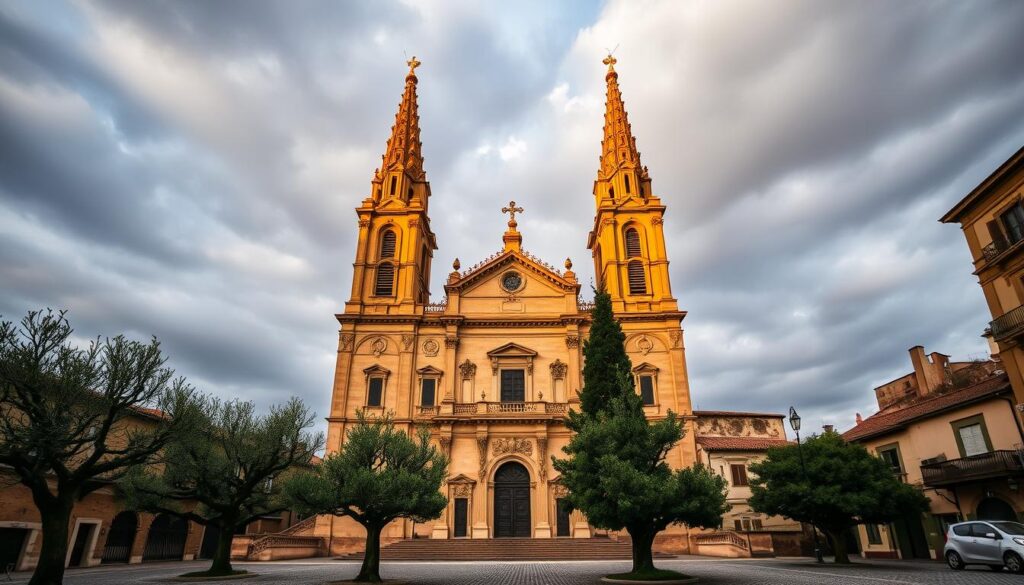I wandered through Teruel in March, a quiet provincial capital where Mudéjar bell towers puncture the sky and jamón ibérico comes at a price that surprised me.
This city feels like a living archive. Its identity is shaped by an 800-year-old tale about two young lovers whose fate still moves locals and visitors.
I found the story honored everywhere: in alabaster sarcophagi at the Fundación Amantes de Teruel, in school recitations, and under the Church of San Pedro where mummies were linked to the 13th century by carbon dating.
The narrative traces a painful split: two lovers separated for five years by status and fortune. That conflict gives the tale its tragic power and makes the city more than a stop on a map.
Key Takeaways
- Teruel is a small city whose identity centers on a tragic story of love.
- The tale tied to Los Amantes de Teruel reaches back to the 13th century.
- Museum sites and a mausoleum let visitors trace legend and history.
- The lovers were said to be apart for five years, a detail that shapes the drama.
- My visit highlighted how medieval art and local ritual keep this story alive today.
Why I’m Revisiting the Legend in the Present Day
I return to this old tale because it shapes how I move through the city today. I often felt pleasantly alone as a tourist, free to study Mudéjar detail and taste local jamón without crowds.
Walking up the Escalinata, through church courtyards, and across quiet plazas made the story feel immediate. Guides told me that preserving the tale matters more than proving every historical fact about the mummies.
That balance—fact and feeling—is the way I frame this piece. I write to give readers a clear path: where to walk, when to visit, and how to let a small town’s past become part of your own life.
“Each year around mid-February, the community turns daily life into theater and the town’s memory resurfaces.”
- I want readers to slow down and spend time with places, not rush past them.
- My goal is a practical and narrative guide for thoughtful travel.
The Legend of the Lovers of Teruel: A 13th-Century Love and Loss
I trace a bargain that changed two lives: Isabel Segura and Diego Marcilla pledged a waiting period of five years so Diego could win fortune and rank.
Isabel was the only child of a wealthy man; Diego came from a reduced noble line. Her father insisted on an advantageous match, so Diego left for Barcelona to join forces mustering there and later took part in key campaigns, including a famous battle.
War, returns, and a fatal deadline
Letters that might have reached Isabel likely never arrived. After years abroad, Diego raced home but arrived a day too late. He begged for a mercy kiss; when Isabel refused because of her new marriage, he fell dead at her feet.
“Give me a kiss or I die,” the story records—his last word before he fell dead.
- I note that family pressure—especially Isabel’s father—shaped this outcome.
- At the funeral in San Pedro Isabel kissed his body, then died, and both families agreed on a joint burial.
This episode ties story to place: those streets, the house sites, and San Pedro make the tale tangible when you walk them today.
Did It Really Happen? Between Legend, Mummies, and Memory
When I stood inside San Pedro, the past felt oddly present. The church space makes the story concrete without forcing an answer.
In 1619 workmen opened a grave under the side chapel of San Cosme y San Damián. They found two mummies: a man and a woman aligned as if sharing a quiet moment.
1619 Exhumation and scientific dating
Later research used carbon dating and placed the remains in the 13th century. That timing fits the town narrative, though the paperwork that names them is debated.
Documents, debates, and what matters
Guides and locals told me that a 1555 document cited by notary Juan Yagüe de Salas links names to the bones. Still, most agree that preserving the story and its cultural role outweighs absolute proof.
“Seeing a body in a sacred space turns a distant tale into a present encounter.”

| Year | Find | Evidence |
|---|---|---|
| 1619 | Two mummies unearthed | Exhumation under side chapel |
| 1555 (doc) | Notarial reference | Juan Yagüe de Salas citation |
| Modern | Dating | Carbon tests → 13th century |
- Visual: alabaster tombs show them side by side but not touching.
- Meaning: death in this story is literal and symbolic.
- Visit: my guided tour at the mausoleum tied these facts into place-based memory.
Where the Story Lives in Teruel: Churches, Art, and City Landmarks
In this town the past turns up in unexpected corners: a relief on a stair, a brick tower, a quiet square.
The Fundación Amantes de Teruel anchors the tale in one place. Its exhibits, audio guides, and dramatized storytelling prepare you before a visit to the mausoleum and the alabaster sarcophagi.
Escalinata and public storytelling
The neomudéjar Escalinata (1921) greets arrivals with a carved relief of Isabel and Diego. I walked it from the station and felt the story begin in stone.
Mudéjar towers and the cathedral skyline
Teruel’s Mudéjar ensemble — the cathedral and the towers of San Salvador, San Martín, and San Pedro — frames the city. Climb Torre del Salvador for panoramic views and a clear sense of the 13th century heritage.
Squares, aqueducts, and a mapped walk
Plaza del Torico, Los Arcos Aqueduct, and Paseo del Óvalo link sites into a single route. I recommend starting at the foundation, moving to the church san pedro, then following streets that show how art and memory share every side of this town.
- Start at the Fundación Amantes de Teruel.
- Visit the church for guided interior context.
- Climb the Escalinata to meet the city’s visual prologue.
“Seeing these sites in sequence turns a visit into a layered way to read history and love.”
From Tragic Story to Living Tradition: “The Marriage of Isabel de Segura” Festival
Each February Teruel reawakens as a living stage where townspeople wear history like a garment. The annual festival—often timed near Valentine’s Day—fills plazas with costume, song, and drama.
I watched scenes that map the narrative arc: Isabel’s wedding, Diego’s return, and the funeral. More than 120 groups took part. Markets, music, dances, falconry, and staged sword fighting set a 13th-century mood.
What to expect and how to plan
Arrive early for good vantage points and check schedules. This event is a Festival of National Tourist Interest, so organizers publish routes and tickets.
- Watch the wedding and the return first; those scenes carry the emotion.
- Look for quiet details—a husband’s face in the wedding or the hush before the funeral kiss.
- Book lodging well ahead and confirm times for parades and performances.
| Event | Where | Why to watch |
|---|---|---|
| Isabel’s wedding | Main plaza | Sets the marriage and social stakes |
| Diego’s return | Escalinata and streets | Drama peaks; battle demonstrations add context |
| Funeral scene | San Pedro area | Emotional climax—tragic story made visible |
| Medieval market | Multiple squares | Food, crafts, music—immersive city time |
“The city becomes a 13th-century stage; crowds transform public space into memory.”
I recommend simple medieval accessories and a short read on Isabel Segura before you arrive. The festival is how locals keep los amantes alive and how lovers teruel remains a living cultural event.
Travel Notes for Lovers of Teruel Today
I treat San Pedro as a place to learn first, then to linger, because guided context deepens what you see. Start by checking opening hours for the church san pedro and booking a guided tour at the Fundación mausoleum when possible.
Church San Pedro and the mausoleum: hours, guided tours, and what I look for
Guided visits include dramatized audio, access to alabaster tombs, and clear links between exhibits and the local story. I look closely at the alabaster figures and the carvings on the side of the sarcophagi for symbolic details.
I keep notes on dates, phrasing, and artifacts the guide emphasizes so my retelling stays accurate. Allow time to visit the cathedral and Torre del Salvador afterward for a view that frames the whole city.
City flavors: jamón de Teruel, migas, and sweets between site visits
Pair walking with food. I pause for Teruel Ham (DO), rustic migas, garlic soup, or ternasco. For sweets I save room for suspiros de amante or pastel borrachos between stops.
My usual way is a short loop: up the Escalinata, across Plaza del Torico, along Los Arcos, and back by quiet lanes. End with one last look at San Pedro’s façade as evening hush turns the place toward reflection and love.
Conclusion
What stays with me is how a small promise still guides a whole town. The story here is both a public ritual and a private ache: a pledge of five years, a day too late, and a tragic story that asks how honor and love collide.
I think about the father and family pressures that forced hard choices. A single word unsaid, a refused kiss, a husband and a grieving woman—these details give the tale its sharp edge.
Visit the church, stand by alabaster tombs, and watch the festival to see how the legend gains body in place. Come for the lovers teruel tale, stay for Mudéjar towers, cathedral views, and local food. Leave with a fragment of this city’s life and a story to tell.


Lascia un commento